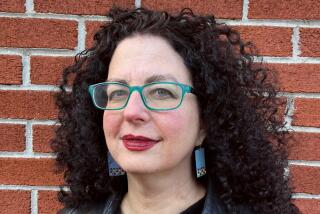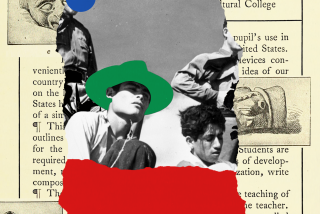A Historic Guide to Style Over Substance
- Share via
Take it as a given that all TV networks do what they can to reach younger viewers. Yet the elevation of style over substance reaches a level of absurdity best described by the one-word names given perfumes--Obsession? Myopia?--when it demands sifting the sands of history through an MTV-filtered prism.
Consider the document the History Channel distributed to producers last month, which at first glance read as if someone from “Saturday Night Live” must have written it. Apparently concerned that channel-surfers are put off by seeing tweedy graybeards discussing World War II or the Aztecs, the network issued “visual and editorial” guidelines urging filmmakers to “give younger experts a chance on camera.... This country is filled with younger historians dying to get a chance to strut their stuff. Don’t rely on old faithfuls.... We are depending on you to find the best storyteller; he or she doesn’t have to be the leading academic on the topic.”
Just to make clear it wasn’t a joke, the channel stressed that if these parameters aren’t followed, “we will request additional shooting. We hope this notice calls attention to our seriousness.”
Seriousness about the policy mandate, yes. Seriousness about history? OK, as long as it appeals to adults under 50 with plenty of disposable income.
Notably, youth is only one aspect of the channel’s criteria for who gets admitted to the expert club--the sort of idiotic knee-jerk push hardly confined to the History Channel, by the way, but rather illustrative of TV’s general requirements for enrollment in the talking-head class, which often have less to do with what’s being said than who’s saying it.
Another provision of the updated standards, for example, suggests that ugly historians need not apply, either. “The person has to be telegenic, well groomed and dressed properly to reflect the mood of the program,” the guidelines note, pressing for interview locations to be “active and exciting. Put them outside if that makes sense ... in a setting that is relevant to the topic. If they can walk and talk, great.”
This isn’t to say that the channel is rigid about its mandate to be young, bold and ambulatory. “Exceptions are certainly accepted for eyewitnesses and/or participants in the events you’re producing the program about,” the memo states. In other words, producers need not find a 35-year-old World War II veteran to interview, though one suspects that if any existed, it would be considered a bonus.
One producer who has worked for the channel--and asked to be kept anonymous, to keep alive the possibility of working there again--chalked up the correspondence to advertising’s influence on programming decisions, saying with resignation, “Madison Avenue is driving the television world absolutely mad.”
At a minimum, pressure to attract the audience media buyers covet inspires the media to put the cart before the horse--or better yet, trample the horse in pursuit of the demographic that rides skateboards and mopeds.
Representatives of the History Channel--one of the A&E; networks, a joint venture of Hearst Corp., ABC and NBC, companies that presumably know something about news--stressed that the style guide merely represents a means of exerting quality control over productions. The goal is to recognize demands of a visual medium, they say, insisting that they can do so without compromising content.
“We’ve created an environment where history can be fun and engaging ... without ever losing our quality or integrity,” said History Channel Executive Vice President/General Manager Abbe Raven.
The channel seeks experts with impeccable credentials, Raven added, and draws on a variety of sources--not all of them used on camera--to ensure accuracy. That said, she acknowledged a desire to make programs as accessible as possible and “find, and groom, that next generation of historians.”
Although she took exception to being lumped in with TV news (“We are nowhere in the same camp as what the news networks are doing”), Raven also expressed enthusiasm about exploring new avenues to get people excited about history--such as having last week’s travel series “Hit the Road” hosted by Jason Sehorn, a pro football star known for pounding wide receivers, not hitting the books.
It’s easy to lump the guidelines in with other blatant examples of entertainment industry ageism, an issue raised again in what amounted to a made-for-TV press conference last week.
More than anything, however, what’s most stunning about the rules--and the muddled logic behind them--is their sheer inanity.
After all, if I’m clamoring to watch something hot, young and sexy at that moment, the History Channel isn’t going to be my first stop, unless the experts can compete with whatever’s on Cinemax. Conversely, if I want to learn about the Hindenburg or just find out if the Dodgers won, whether the historian or sportscaster has washboard abs, perfect hair or full, luscious lips won’t make me more inclined to stay tuned.
Besides, if the top expert in the field is available, and I care enough about the topic at hand to watch, then call me wacky, but that’s who I want to hear from, not Conan the Historian.
Granted, it’s understood that television is driven by pictures and most of us, fairly or not, would rather watch beautiful people than unattractive ones--whether the task is delivering news or pontificating about ancient Egypt.
No wonder luminaries within the pundit ranks--such as Ann Coulter, who became a fixture on ABC’s since-defunct “Politically Incorrect With Bill Maher” by mixing conservative politics with short skirts--seemingly ascend based as much on their looks as on political insights.
Perhaps most disconcerting about this is the sense that the few havens left where packaging doesn’t trump the actual product might be disappearing. Can’t there be a couple of channels where knowing something most people don’t matters most, and where looks aren’t the be-all and end-all? I mean, if the History Channel feels it has to resemble E!’s “Wild On” to compete for ad dollars, I give up.
It might even be time--dare I say it?--to crack open a book.
*
Brian Lowry’s column appears Wednesdays. He can be reached at brian.lowry@latimes.com.
More to Read
The complete guide to home viewing
Get Screen Gab for everything about the TV shows and streaming movies everyone’s talking about.
You may occasionally receive promotional content from the Los Angeles Times.






